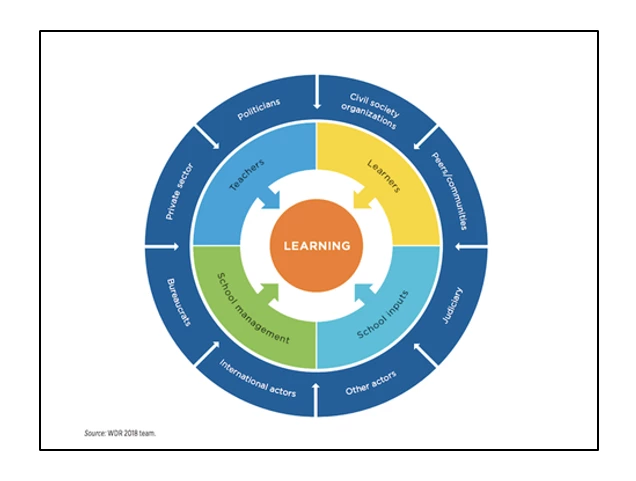In a sector where a proliferation of research seemingly has contributed at least as much to confusion as to progress, the 2018 World Development Report (WDR), Learning to Realize Education’s Promise sheds new light, and points towards fresh, hopeful pathways forward. It is a landmark contribution.
“Education for all” was the seductive promise of the millennium. Yet all too many children are attending school without acquiring even basic literacy or numeracy. Why?
The determinants of educational outcomes
There is no shortage of explanations as to where the problem lies, and suggestions for doing better. The trouble, as Lant Pritchett puts it, is that: “Pretty much everything everyone believes is the key element of better schools has, by now, been rigorously disproved to have an impact on student learning somewhere. Of course, many of these same notions have also been rigorously proven to have an impact on student learning somewhere else.” (p.7) What we need is a way through this seeming morass, of structuring and cutting through the complexity, helping sort what is central from what is peripheral. This is what the 2018 World Development Report provides.
The WDR organizes its discussion around the deceptively simple framework laid out in the three-concentric-circles figure at the beginning of this review. Learning, the ‘bullseye’ at the center of the figure, is the target.
The middle concentric circle comprises four sets of “immediate school-level ingredients” for learning:
- Prepared learners – adequate child health, support (or otherwise) from families and communities, prior early child development (ECD) opportunities for learning.
- Skilled and motivated teachers – “teachers are the most important factor affecting learning” (p.10); their formal skills make a difference; so, too, does whether they show up, are committed to a teaching mission, and work to continually upgrade their skills.
- Learning focused inputs – not only the quantum of resources provided, but also whether the inputs get to the classroom in a way which supports learning. And
- School management – which indirectly has a powerful influence on both teacher quality and whether inputs are used effectively.Technical analysis of how to better supply the above ingredients is necessary; it provides the knowledge base for continuing improvement of education practice. But it also is limited.
As the outer circle in the figure suggests, technocratic decisions are not made in a vacuum: They are embedded within a much more complex - and much more political - system of actors and their incentives. In a complex system, each of the various actors bases their actions on expectations of how other actors behave. The incentives and behaviors of these actors could be either contradictory or aligned. In an aligned system, the expectations of the players are c oherent – in the sense that each of the players base their actions on accurate perceptions of the behavior of other stakeholders in the system. But coherent towards what purpose?
The desirable answer, as the bullseye at the center of the concentric circles diagram signals, is coherently aligned towards learning. That, however, is not the only possibility. Education systems can be aligned around patronage - or, in part as a way of managing patronage pressures without falling foul of the law, around a pre-occupation with ‘process compliance’. The result is that many education systems are, as the WDR puts it, “stuck in low-learning traps”.
Transforming misaligned systems of education - entry points for change
How might progress be achieved in systems which are not aligned towards learning? One classic debate concerns the relative merits of ‘big-bang’ and more incremental approaches. The WDR is unequivocal in its rejection of a ‘best practices’ (‘just do it’) approach to reform. Given the many interdependencies, the law of unintended consequences looms large. It concludes that: “a gradual, negotiated approach to reform may work better than confrontation”.
What this amounts to in practice varies with the ways in which broader political and bureaucratic contexts interact with incremental initiatives. Using the WDRs coherence-alignment framework, three distinct contexts can be distinguished:
- In education systems which are coherent and aligned towards learning, incrementalism is part of the ongoing process of seeking out opportunities for continuous improvement – the returns are especially high from research and practical innovations in pedagogy, and in other immediate influences on the teacher-learner relationship.
- In education systems which are fragmented and lack coherence – this often is a reflection of a more broadly-fragmented clientelist polity - incrementalism will have space to take root within the systems’ cracks, and for ‘islands of effectiveness’ (such as this school-level example) to emerge.
- Where an education system is coherent and captured, there will be little space for incremental approaches to take root.
The WDR advocates for: “ mobilizing support and building coalitions to improve learning” (p.203). It highlights the role of better information on learning outcomes – not only as a tool for more effective decision-making by education sector professionals, but as an aspect of advocacy, with transparent reporting on school-by-school outcomes signaling to politicians, voters, parents and communities both the limitations of the status quo, and what might be achievable.
Orchestrating interests and leveraging information are powerful tools – but what potentially makes them transformative is not so much coalition-building per se, but their broader impact on a society’s ideas as to how an education system should function. A shift from patronage/process compliance to learning is as at least as much a shift in ideas about the world of schooling and ones place in it as it is a reconfiguration of interests.
‘Education for all’ was a powerful example of a transformative idea. But for all of the gains which it helped to catalyze, it turns out to be unhelpful vis-à-vis the frontier challenge of improving educational outcomes. It induces a narrow focus on top-down approaches to implementation, aligning action towards input expansion and process compliance, not towards doing what it takes to improve quality.
Consider, by contrast, the implications for action were education stakeholders to embrace the idea of unambiguous commitment to a learning-oriented education system:
- Political leaders could champion the vision of a thriving, inclusive society, with a high-quality, learning-oriented education system which provides opportunities for all – and in which all citizens play an active role.
- Parents and communities could support childrens’ preparedness – and help safeguarding schools against stakeholders who prioritize interests other than learning.
- Bureaucracies could move beyond narrow pre-occupations with ‘process compliance’, or access as an end in itself, and embrace a learning-oriented engagement
- Teacher unions might move beyond an exclusive pre-occupation with the material conditions of teachers and increasingly embrace a vision of teaching as a profession, as a calling.
- New possibilities would arise for adapting national policies (for example towards testing, examinations, and transparency) in ways that enhance a focus on educational outcomes.
- Civil society activism might more systematically target those aspects of education sector governance which have strong impacts on learning.
A longer, more comprehensive version of this review first appeared at https://workingwiththegrain.com/2018/03/12/navigating-educations-complexity-a-review-of-the-2018-wdr/



Join the Conversation